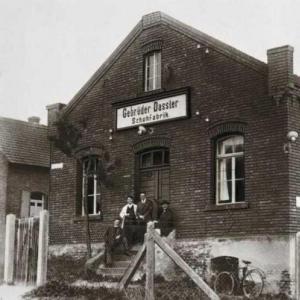History of the development of genetics. Presentation on biology on the topic "history of the development of genetics" History of the development of genetics presentation
Chimera is the product of Typhon and Echidna, an unprecedented creature with a lion’s mouth, a goat’s body and a snake’s tail (from ancient Greek mythology) And what do they see?.. At the table
Monsters sit around:
One with horns and a dog's face,
Another with a rooster's head,
There's a witch with a goat beard,
Here the frame is prim and proud,
There's a dwarf with a ponytail, and here
Half crane and half cat.
A.S. Pushkin
LESSON TOPIC: GENETICS: HISTORY OF SCIENCE DEVELOPMENT
LESSON OBJECTIVES:
Get acquainted with the science of genetics and its historyand achievements.
Determine the goals and objectives of genetics in
modern world.
Show the role of genetic knowledge in the decision
global problems of humanity.
Develop the ability to independently find
information in the media and use it in educational
activities.
GENETICS (Greek Genesis - origin) - the science of heredity and variability of organisms
GENETICS (Greek Genesis - origin) the science of heredity andvariability of organisms
Charles Darwin 1809-1882
Nominatedhypothesis
pangenesis in 1868
(transmission through blood flow
each gamete has an embryo -
hemulus, from which
the same one is developing
cell).
The basis of this hypothesis
originates from the ancient
physician Hippocrates.
Gregor Johann Mendel (1822 – 1884)
Austrian naturalist, monk,founder of the doctrine of heredity
1865 “Experiments on plants
hybrids"
created scientific principles of description and
research on hybrids and their offspring;
developed and applied algebraic
system of symbols and designations of features;
formulated the basic laws
inheritance of characteristics over a series of generations,
allowing predictions to be made.
expressed the idea of existence
hereditary inclinations (or genes, as they are called)
then they started calling
August Weismann 1834-1914
Weisman rightly argued thatquestion of inheritance of acquired property
signs can only be resolved with
with the help of experience and experimentally
showed the non-heritability of mechanical
damage.
author
speculative
theories
heredity
And
individual
development, incorrect in detail, but in
principle anticipating modern
ideas about the discreteness of media
hereditary information and their connections
with chromosomes
concepts
O
roles
hereditary
inclinations in individual development
1900 – the birth of genetics
Hugo De Vries (1848 – 1935) - Dutch scientistErich Chermark – Seisenegg (1871 -1962)
scientist
Karl Erich Correns (1864 – 1933) – German scientist
–
Austrian
independently of each other
rediscovered G. Mendel's laws
“Gene is just a short and convenient word that can easily be combined with others...”
In 1906, William Batson (1861 – 1926)- English scientist, proposed the term
"genetics" to refer to new science
In 1909, Danish biologist Wilhelm
Ludwig Johansen (1857 – 1927)
coined the term "gene" in a book
"Elements of the exact doctrine of
variability and heredity"
Thomas Hunt Morgan (1866 – 1945)
1933 Nobel Prizein physiology and medicine
for experimental
justification
chromosome theory
heredity
“...genes are located in
chromosomes in
linear order and
form a group
clutch..."
N.I. Vavilov (1887 - 1943) - Russian geneticist, plant breeder, geographer, organizer and first director (until 1940) of the Institute of Genetics of the USSR Academy of Sciences.
1922 – “lawhomologous series" about genetic proximity
related groups
plants
1926 – “Centers
origin and
diversity
cultivated plants"
Lysenko and Lysenkoism
Lysenko Trofim Denisovich(1898 – 1976)
creator of pseudoscientific
"Michurin's teaching" in biology;
denied classical genetics as
“idealistic” and bourgeois;
asserted the possibility
"rebirth" of one species into
another;
As a result of monopoly
Lysenko and his supporters in the USSR
in the 30s - 40s they were defeated
scientific schools in genetics,
honest scientists are defamed,
the development of biology has slowed down and
Agriculture.
History of genetics in dates
1935 - experimental determination of gene sizes1953 – DNA structural model
1961 – deciphering the genetic code
1962 – first cloning of a frog
1969 – the first gene was chemically synthesized
1972 – birth of genetic engineering
1977 – the genome of bacteriophage X 174 was deciphered,
First human gene sequenced
1980 – the first transgenic mouse was produced
1988 – The Human Genome Project was created
1995 – formation of genomics as a branch of genetics,
bacterial genome sequenced
1997 – Dolly the sheep was cloned
1999 – a mouse and a cow were cloned
2000 – the human genome was read! "Deciphering the structure
genome is the point on the first
page in a thick book,
which still needs to be written
humanity. Begins
new, third stage in
biology: after Darwinian,
descriptive, and molecular
biology of the last 50 years
functional biology,
which will be directly
to influence people's lives"
acad. L. Kiselev
"Man is the most
he himself is interested in the world. All,
what has to do with it,
- subject of the highest
attention. In time it came
understanding that everything
depends on biology
human, and all biology
a person depends on the genome.
Kozma Prutkov said: look in
root. In the human body
the main “root” is
genome"
prof. V.Z. Tarantula
The importance of genetics in the modern world
GENETIC DISCOVERIES: good or evil?
“The further progress of mankind is largelyassociated with the development of genetics. At the same time
it must be taken into account that uncontrolled
spread of genetically engineered living
organisms and products may disrupt
biological balance in nature and represent
threat to human health."
V. A. Avetisov
designations when compiling a pedigree
I think genetics is the most ________section of biology because _______ .
By studying genetics, I want to _____________.
In my opinion, knowledge of genetics
necessary for me in my life, because ___________
AT HOME
notes in a notebookmedia clippings about
the importance of genetics in
Nowadays
Slide 1
Slide 2
 The phenomena of heredity and variability of traits have been known since ancient times. The essence of these phenomena was formulated in the form of empirical rules: “The apple doesn’t fall far from the tree”, “Do not expect a good breed from a bad seed”, “Not into a mother, not into a father, but into a passing young man”, etc. Natural philosophers of the ancient world tried to explain the reasons for the similarities and differences between parents and their descendants, between brothers and sisters, the mechanisms of sex determination, and the reasons for the birth of twins. The continuity of generations was described by the terms “genus” (genus), “gennao” (giving birth), “geneticos” (related to origin), “genesis” (origin).
The phenomena of heredity and variability of traits have been known since ancient times. The essence of these phenomena was formulated in the form of empirical rules: “The apple doesn’t fall far from the tree”, “Do not expect a good breed from a bad seed”, “Not into a mother, not into a father, but into a passing young man”, etc. Natural philosophers of the ancient world tried to explain the reasons for the similarities and differences between parents and their descendants, between brothers and sisters, the mechanisms of sex determination, and the reasons for the birth of twins. The continuity of generations was described by the terms “genus” (genus), “gennao” (giving birth), “geneticos” (related to origin), “genesis” (origin).
Slide 3
 Modern genetics is based on the patterns of heredity discovered by G. Mendel when crossing different varieties of peas (1865), as well as the mutation theory of H. De Vries (1901–1903). However, the birth of genetics is usually attributed to 1900, when H. De Vries, K. Correns and E. Cermak rediscovered G. Mendel’s laws. In 1906, based on the root “gene”, W. Bateson (England) proposed the term “genetics”, and in 1909 V.L. Johannsen proposed the term "gene".
Modern genetics is based on the patterns of heredity discovered by G. Mendel when crossing different varieties of peas (1865), as well as the mutation theory of H. De Vries (1901–1903). However, the birth of genetics is usually attributed to 1900, when H. De Vries, K. Correns and E. Cermak rediscovered G. Mendel’s laws. In 1906, based on the root “gene”, W. Bateson (England) proposed the term “genetics”, and in 1909 V.L. Johannsen proposed the term "gene".
Slide 4
 Back in 1883–1884. V. Roux, O. Hertwig, E. Strassburger, and A. Weissman (1885) formulated the nuclear hypothesis of heredity, which at the beginning of the 20th century. developed into the chromosomal theory of heredity (W. Setton, 1902–1903; T. Boveri, 1902–1907; T. Morgan and his school). T. Morgan also laid the foundations of the gene theory, which was developed in the works of domestic scientists of the school of A.S. Serebrovsky, who formulated it in 1929–1931. ideas about the complex structure of the gene. These ideas were developed and concretized in studies of biochemical and molecular genetics, which led to the creation of a DNA model by J. Watson and F. Crick (1953), and then to the deciphering of the genetic code that determines protein synthesis.
Back in 1883–1884. V. Roux, O. Hertwig, E. Strassburger, and A. Weissman (1885) formulated the nuclear hypothesis of heredity, which at the beginning of the 20th century. developed into the chromosomal theory of heredity (W. Setton, 1902–1903; T. Boveri, 1902–1907; T. Morgan and his school). T. Morgan also laid the foundations of the gene theory, which was developed in the works of domestic scientists of the school of A.S. Serebrovsky, who formulated it in 1929–1931. ideas about the complex structure of the gene. These ideas were developed and concretized in studies of biochemical and molecular genetics, which led to the creation of a DNA model by J. Watson and F. Crick (1953), and then to the deciphering of the genetic code that determines protein synthesis.
Slide 5
 Peculiarities of the development of domestic genetics The development of genetics in our country began in the first years of Soviet power. In 1919, the Department of Genetics was created at Petrograd University, headed by Yuri Aleksandrovich Filipchenko. In 1930, the Laboratory of Genetics of the USSR Academy of Sciences was opened under the leadership of Nikolai Ivanovich Vavilov (since 1933 - Institute of Genetics). In the 1920s–1930s. our country was a leader in all areas of genetics.
Peculiarities of the development of domestic genetics The development of genetics in our country began in the first years of Soviet power. In 1919, the Department of Genetics was created at Petrograd University, headed by Yuri Aleksandrovich Filipchenko. In 1930, the Laboratory of Genetics of the USSR Academy of Sciences was opened under the leadership of Nikolai Ivanovich Vavilov (since 1933 - Institute of Genetics). In the 1920s–1930s. our country was a leader in all areas of genetics.
Slide 6
 Koltsov Nikolai Konstantinovich - predicted the properties of carriers of genetic information; developed the gene theory; developed the doctrine of social genetics (eugenics).
Koltsov Nikolai Konstantinovich - predicted the properties of carriers of genetic information; developed the gene theory; developed the doctrine of social genetics (eugenics).
Slide 7
 Vavilov Nikolai Ivanovich - formulated the law of homological series, developed the doctrine of a species as a system.
Vavilov Nikolai Ivanovich - formulated the law of homological series, developed the doctrine of a species as a system.
Slide 8

Slide 9
 Serebrovsky Alexander Sergeevich - created the doctrine of the gene pool and genogeography: “I called the totality of all the genes of a given species the gene pool in order to emphasize the idea that in the form of the gene pool we have the same national wealth as in the form of our coal reserves hidden in our depths "
Serebrovsky Alexander Sergeevich - created the doctrine of the gene pool and genogeography: “I called the totality of all the genes of a given species the gene pool in order to emphasize the idea that in the form of the gene pool we have the same national wealth as in the form of our coal reserves hidden in our depths "
Slide 10
 Chetverikov Sergei Sergeevich - in his work “On some aspects of the evolutionary process from the point of view of modern genetics” he proved the genetic heterogeneity of natural populations.
Chetverikov Sergei Sergeevich - in his work “On some aspects of the evolutionary process from the point of view of modern genetics” he proved the genetic heterogeneity of natural populations.
Slide 11
 Dubinin Nikolai Petrovich - proved the divisibility of the gene; independently of Western researchers, he established that probabilistic, genetic-automatic processes play an important role in evolution.
Dubinin Nikolai Petrovich - proved the divisibility of the gene; independently of Western researchers, he established that probabilistic, genetic-automatic processes play an important role in evolution.

Gregor Johann Mendel (1822 - 1884) Austrian naturalist, monk, founder of the doctrine of heredity in 1865. “Experiments on plant hybrids” created scientific principles for the description and study of hybrids and their offspring; developed and applied an algebraic system of symbols and notation of features; formulated the basic laws of inheritance of traits over a series of generations, allowing predictions to be made. expressed the idea of the existence of hereditary inclinations (or genes, as they later came to be called

1900 - the birth of genetics Hugo De Vries (1848 - 1935) - Dutch scientist Erich Chermark - Zeisenegg () - Austrian scientist Karl Erich Correns (1864 - 1933) - German scientist independently rediscovered G. Mendel's laws

“Gene is simply a short and convenient word that easily combines with others...” In 1906, William Bateson (1861 – 1926), an English scientist, proposed the term “genetics” to designate a new science. In 1909, the Danish biologist Wilhelm Ludwig Johansen (1857 – 1927) proposed the term “gene” in the book “Elements of the exact doctrine of variability and heredity”


N.I. Vavilov (1887 – 1943) - Russian geneticist, plant breeder, geographer, organizer and first director (until 1940) of the Institute of Genetics of the USSR Academy of Sciences - “the law of homological series” - on the genetic proximity of related groups of plants 1926 – “Centers of origin and diversity of cultivated plants”

Lysenko and Lysenkoism Lysenko Trofim Denisovich (1898 – 1976) creator of the pseudoscientific “Michurin doctrine” in biology; rejected classical genetics as “idealistic” and bourgeois; asserted the possibility of “degeneration” of one species into another; As a result of the monopoly of Lysenko and his supporters in the USSR in the 30s and 40s, scientific schools in genetics were destroyed, honest scientists were defamed, and the development of biology and agriculture was slowed down.

History of genetics in dates 1935 - experimental determination of gene sizes 1953 - structural model of DNA 1961 - decoding of the genetic code 1962 - first cloning of a frog 1969 - the first gene was chemically synthesized 1972 - the birth of genetic engineering 1977 - the genome of bacteriophage X 174 was deciphered, the first human gene was sequenced 1980 – the first transgenic mouse was obtained 1988 – the “Human Genome” project was created 1995 – the establishment of genomics as a branch of genetics, sequencing the bacterial genome 1997 – Dolly the sheep was cloned 1999 – a mouse and a cow were cloned 2000 – the human genome was read!

“Deciphering the structure of the genome is a point on the first page of a thick book that humanity has yet to write. A new, third stage in biology begins: after Darwinian, descriptive, and molecular biology of the last 50 years, functional biology, which will directly influence people’s lives,” acad. L. Kiselev “A person is more interested in himself than anything else in the world. Everything that has to do with it is the subject of the highest attention. Over time, the understanding came that everything rests on human biology, and all human biology rests on the genome. Kozma Prutkov said: look at the root. In the human body, the main “root” is the genome,” Prof. V.Z. Tarantula
 GENETIC DISCOVERIES: good or evil? “The further progress of humanity is largely related to the development of genetics. At the same time, it must be taken into account that the uncontrolled spread of genetically engineered living organisms and products can disrupt the biological balance in nature and pose a threat to human health.” V. A. Avetisov
GENETIC DISCOVERIES: good or evil? “The further progress of humanity is largely related to the development of genetics. At the same time, it must be taken into account that the uncontrolled spread of genetically engineered living organisms and products can disrupt the biological balance in nature and pose a threat to human health.” V. A. Avetisov


Slide 2
- The phenomena of heredity and variability of traits have been known since ancient times.
- The essence of these phenomena was formulated in the form of empirical rules: “The apple doesn’t fall far from the tree”, “Do not expect a good breed from a bad seed”, “Not into a mother, not into a father, but into a passing young man”, etc.
- Natural philosophers of the ancient world tried to explain the reasons for the similarities and differences between parents and their descendants, between brothers and sisters, the mechanisms of sex determination, and the reasons for the birth of twins.
- The continuity of generations was described by the terms “genus” (genus), “gennao” (giving birth), “geneticos” (related to origin), “genesis” (origin).
Slide 3
- Modern genetics is based on the patterns of heredity discovered by G. Mendel when crossing different varieties of peas (1865), as well as the mutation theory of H. De Vries (1901–1903).
- However, the birth of genetics is usually attributed to 1900, when H. De Vries, K. Correns and E. Cermak rediscovered G. Mendel’s laws.
- In 1906, based on the root “gene”, W. Bateson (England) proposed the term “genetics”, and in 1909 V.L. Johannsen proposed the term "gene".
Slide 4
- Back in 1883–1884. V. Roux, O. Hertwig, E. Strassburger, and A. Weissman (1885) formulated the nuclear hypothesis of heredity, which at the beginning of the 20th century. developed into the chromosomal theory of heredity (W. Setton, 1902–1903; T. Boveri, 1902–1907; T. Morgan and his school).
- T. Morgan also laid the foundations of the gene theory, which was developed in the works of domestic scientists of the school of A.S. Serebrovsky, who formulated it in 1929–1931. ideas about the complex structure of the gene.
- These ideas were developed and concretized in studies of biochemical and molecular genetics, which led to the creation of a DNA model by J. Watson and F. Crick (1953), and then to the deciphering of the genetic code that determines protein synthesis.
Slide 5
Features of the development of domestic genetics
- The development of genetics in our country began in the first years of Soviet power. In 1919, the Department of Genetics was created at Petrograd University, headed by Yuri Aleksandrovich Filipchenko. In 1930, the Laboratory of Genetics of the USSR Academy of Sciences was opened under the leadership of Nikolai Ivanovich Vavilov (since 1933 - Institute of Genetics).
- In the 1920s–1930s. our country was a leader in all areas of genetics.
Slide 6
- Koltsov Nikolai Konstantinovich - predicted the properties of carriers of genetic information; developed the gene theory; developed the doctrine of social genetics (eugenics).
Slide 7
- Vavilov Nikolai Ivanovich - formulated the law of homological series, developed the doctrine of a species as a system.
Slide 8
- Michurin Ivan Vladimirovich - discovered the possibility of controlling dominance.
Slide 9
- Serebrovsky Alexander Sergeevich - created the doctrine of the gene pool and genogeography: “I called the totality of all the genes of a given species the gene pool in order to emphasize the idea that in the form of the gene pool we have the same national wealth as in the form of our coal reserves hidden in our depths "
Slide 10
- Chetverikov Sergei Sergeevich - in his work “On some aspects of the evolutionary process from the point of view of modern genetics” he proved the genetic heterogeneity of natural populations.
Slide 11
- Dubinin Nikolai Petrovich - proved the divisibility of the gene; independently of Western researchers, he established that probabilistic, genetic-automatic processes play an important role in evolution.
Slide 12
- Shmalhausen Ivan Ivanovich - developed the theory of stabilizing selection; discovered the principle of integration of biological systems.
Slide 13
- Nikolai Vladimirovich Timofeev-Resovsky - laid the foundations of modern population genetics.
Slide 14
- At the August (1948) session of VASKhNIL, power in science was seized by the president of VASKhNIL, academician T.D. Lysenko. He contrasted scientific genetics with a false teaching called “Michurin biology.” Many genetic scientists (N.P. Dubinin, I.A. Rapoport) were deprived of the opportunity to engage in science. Only in 1957 M.E. Lobashev resumed teaching genetics. In 1965 T.D. Lysenko, under pressure from the progressive public (mathematicians, chemists, physicists), lost his monopoly on scientific truth. The Institute of General Genetics of the USSR Academy of Sciences was created, the Society of Genetics and Breeders named after. N. I. Vavilova. At the end of the 1960s. our country has regained its lost position in world science.
View all slides

First attempts
Scientist and doctor of Ancient Greece Hippocrates believed that during the fusion of gametes there is a struggle between the characteristics of the father and mother. And whoever wins this gender of the child will be.

- A method of artificial hybridization (crossing of organisms) has been developed.
- Discovery of dominance traits (predominant trait)

Gregor Mendel
Conducted a series of experiments on
Drew the correct conclusions from
experiment.
1865 Article “Experiments on
plant hybrids"
which discussed
Patterns of inheritance
signs.

Rediscoverers of Mendel's Laws (1900)
Hugo de Vries
Dutch botanist

Karl Erich Correns
German biologist.
Pioneer of genetics in
Germany
Erich Chermak
Austrian scientist
geneticist. Crossed
garden and agricultural plants

- Genetics is the science of heredity and variability.
- Heredity is the ability of organisms to pass on characteristics to their descendants.
- Variability is the ability of organisms to change under the influence of the environment.

- The hybridological method is the crossing of organisms that differ in some characteristics, followed by analysis of the manifestation of these characteristics.
- A pure line is a genetically homogeneous offspring descended from one self-pollinating or self-fertilizing individual.

- Gene-section of DNA
- Allelic genes are genes responsible for the manifestation of one trait.
- Homozygote is an organism containing 2 allelic genes. (AA, BB)
- Heterozygote - an organism containing different allelic genes. (Aa, BB)
- Recessive trait - suppressed (indicated by beeches -a, b)
- Dominant trait - manifested (designated - A, B)

- Female, Male
- X-crossing
- F - generation of descendants (children)
- R- parents
- G-gametes

Complete tasks
- Select homozygous organisms:
AaBB, SS, AaBB, DDCC, FFcc.
Select heterozygous organisms
AaВВ, СС, АаВв, DDCC, FFcc, Аа, СсВв.
List all possible types of gametes:
AaBvSS, AAVvSs.

Homework
- Paragraph No. 38, learn the terms in the notebook.
- Describe all possible variants of gametes in this organism:







